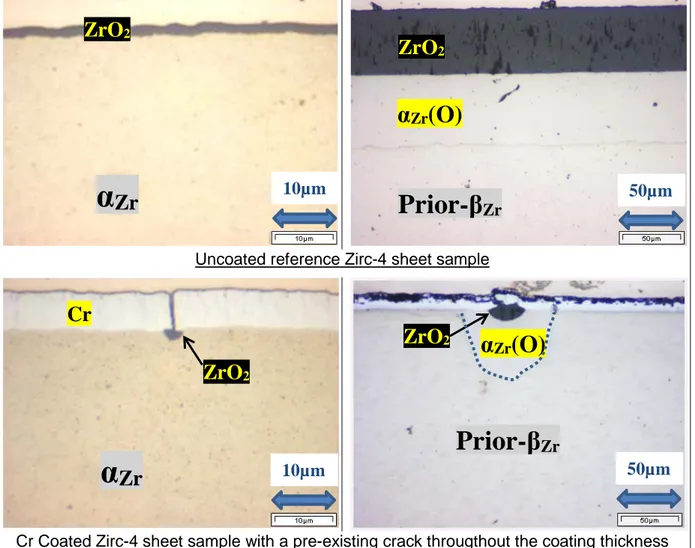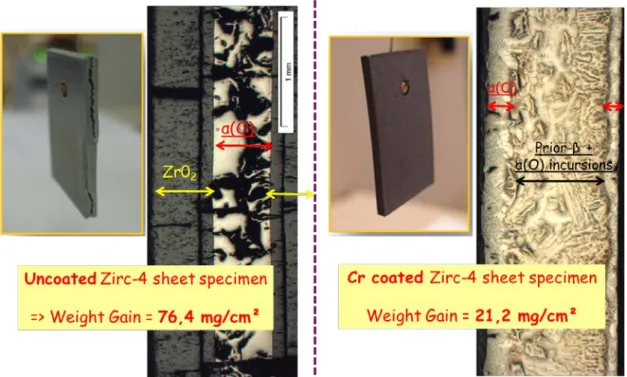HAL Id: cea-02492582
https://hal-cea.archives-ouvertes.fr/cea-02492582
Submitted on 27 Feb 2020HAL is a multi-disciplinary open access archive for the deposit and dissemination of sci-entific research documents, whether they are pub-lished or not. The documents may come from teaching and research institutions in France or abroad, or from public or private research centers.
L’archive ouverte pluridisciplinaire HAL, est destinée au dépôt et à la diffusion de documents scientifiques de niveau recherche, publiés ou non, émanant des établissements d’enseignement et de recherche français ou étrangers, des laboratoires publics ou privés.
On-going studies at CEA on chromium coated zirconium
based nuclear fuel claddings for enhanced accident
tolerant LWRS fuel
F. Schuster, F. Lomello, Alain Billard, G. Velisa, E. Monsifrot, J. Bischoff, A.
Ambard, J.-C. Brachet, M. Lesaux, M. Leflem, et al.
To cite this version:
F. Schuster, F. Lomello, Alain Billard, G. Velisa, E. Monsifrot, et al.. On-going studies at CEA on chromium coated zirconium based nuclear fuel claddings for enhanced accident tolerant LWRS fuel. TopFuel 2015 - Reactor Fuel Performance Meeting, Sep 2015, Zurich, Switzerland. �cea-02492582�
ON-GOING STUDIES AT CEA ON CHROMIUM COATED ZIRCONIUM
BASED NUCLEAR FUEL CLADDINGS FOR ENHANCED ACCIDENT
TOLERANT LWRS FUEL
J.C. Brachet
*, M. Le Saux, M. Le Flem, S. Urvoy, E. Rouesne, T. Guilbert,
C. Cobac, F. Lahogue, J. Rousselot, M. Tupin, P. Billaud, C. Hossepied
CEA, DEN, DMN, Section for Applied Metallurgy Research F-91191 Gif-sur-Yvette, France
F. Schuster, F. Lomello,
CEA, DEN, Cross-Functional-Program on Advanced Materials, F-91191 Gif-sur-Yvette, France
A. Billard, G. Velisa, E. Monsifrot,
IRTES, LERMPS UTBM LRC CEA, site de Montbéliard, F-90010 Belfort, France
J. Bischoff,
AREVA NP, 10 rue Juliette Récamier, F-69456 Lyon, Cedex 06, France
A. Ambard
EDF R&D, département MMC, avenue des Renardières, F-77818 Moret-Sur-Loing, France
* Corresponding Author, E-mail: jean-christophe.brachet@cea.fr
ABSTRACT
Chromium coatings aiming to protect the current zirconium alloy nuclear fuel cladding materials from high temperature steam oxidation, especially in accidental conditions, are being developed at CEA in the framework of the French Nuclear Institute in partnership with AREVA and EDF.
The present paper focuses on recent results obtained on chromium-coated cladding on Zircaloy-4 and substrate. A complementary paper is presented by AREVA [1]. Typical as-fabricated microstructures of chromium coatings are illustrated. Preliminary autoclave oxidation tests at 415°C (steam, 100 bars) have been performed on both uncoated reference materials and on chromium coated Zircaloy-4 based samples, showing very encouraging results for the last generation of Cr coatings fabricated. Additionally, results obtained after High Temperature (HT) oxidation in steam are presented. It is shown that the chromium coatings developed so far may significantly improve the post-HT oxidation clad mechanical properties (i.e. ductility and strength) compared to conventional uncoated materials. As a consequence, the developed chromium coatings provide significant additional margins for loss-of-coolant accident (LOCA) and, to some extent, for beyond LOCA conditions.
1. As-received materials and behavior in nominal conditions
These last years, CEA has studied chromium coatings (thicknesses of a few microns up to ~20µm) on Zircaloy-4 (Zirc-4) substrates, which are able to provide significant additional margins in nominal conditions in light water reactors (LWR) as well as in accidental conditions, such as loss-of-coolant accident (LOCA) [2] [3].
1.1 As-received Cr coating microstructures
Figure 1 illustrates some typical as-received Cr coating microstructures that have been
obtained. It can be observed that:
- The first generation of Cr coatings fabricated shows, sometimes, evidences of cracks and porosities located at the Cr grains boundaries and/or at the Chromium - Zircaloy interface, as shown in Figure 1–(a);
- Generally, the Cr grains display a columnar morphology (Figure 1-(c)) due to the deposition process used, derived from Physical Vapor Deposition (PVD);
- Last generation of Cr coatings (Figure 1-(b)) is characterized by a fully dense microstructure without evidence of defects, as highlighted by high magnification transmission electron microscopy (TEM) examinations on thin foils prepared using the Focus-Ion-Beam (FIB) technique (Figure 1-(d)).
(a) First generation of coating (b) Last generation of coating
(c) Forward Scattered Detectors Imaging (Field Emission Gun Scanning Electron Microscopy, FEG-SEM)
(d) Zircaloy-4/chromium interface as observed by TEM (J. Ribis, B. Arnal, CEA)
Figure 1 – Electron micrographs of some typical as-received Cr coating microstructures
Cr
Cr
Cr
Zr
5 µm
__________
___________
5 µm
2 µm
________
Zr
Cracks1.2 Behavior upon corrosion in nominal conditions
Some preliminary short tests have been performed on the first generation of coated samples at 360°C in autoclave with a representative pressurized water reactor (PWR) primary water environment. The results showed a significant reduction of the oxidation kinetics when compared to reference uncoated materials [2][3]. On-going autoclave tests at 415°C under steam (100 bars) have confirmed these first results. As shown in Figure 2, the weight gain of the last generation of Cr-coated samples is much lower than the uncoated reference materials. A weight gain lower than 4mg/dm² has been measured on last generation of Cr-coated Zircaloy-4 sample after 100 days at 415°C, corresponding to an outer Cr oxide thickness lower than 250 nm. This weight gain is at least 25 times lower than the weight gain obtained on uncoated reference materials, which show a ~8µm thick zirconia outer layer for these autoclave test conditions.
(a)
(b)
Figure 2 – Weight gain of uncoated and Cr-coated materials after autoclave tests at 415°C, under 100 bars steam environment (Fig. 2-a), and visual aspect of last
2. Behavior upon High-Temperature oxidation
2.1 High Temperature behavior in steam for typical DBA-LOCA temperature range
Cr-coated Zircaloy-4 sheets samples and clad segments have been tested in the 1000-1200°C temperature range (typical of design basis accident (DBA) LOCA conditions) under steam, and then water quenched down to Room Temperature (RT) thanks to CEA “DEZIROX” [4] facility. As an example, Figure 3 shows the weight gain evolution as a function of the steam oxidation time at 1200°C and some associated optical micrographs of typical Post-Quenching (PQ) microstructures of uncoated and coated materials. It is obvious from these results that coated materials display a much slower HT steam oxidation kinetics, up to at least 1500 s at 1200°C, thus preventing the prior-βZr substrate from oxygen diffusion and the formation of thick brittle outer ZrO2 and αZr(O) layers. Furthermore, for longer oxidation time, i.e., after one side oxidation for 6000 s at 1200°C, it has been shown that the Cr-coated clad segment is able to survive to the final water quenching down to RT while uncoated reference cladding samples brake into numerous (brittle) fragments [1][3].
(a) Uncoated Zirc-4 after steam oxidation for 300s at 1200°C
(b) Cr coated Zirc-4 after steam oxidation for 300s at 1200°C
Figure 3 – Comparison between the respective HT steam oxidation behaviors at 1200°C of uncoated vs. Cr coated Zircaloy-4 samples
α
Zr(O) ~60µm
ZrO
2~ 55µm
Cr
2O
3~3µm
Non oxidized
residual Cr
metallic layer
20µm
20µm
Prior-
β
ZrDue to their much slower oxidation kinetics, Cr-coated materials exhibit significantly higher PQ residual strength and ductility, as already partially reported in [2] and [3]. For example, Cr-coated clad segments show only a very limited decrease of their residual strength and ductility after steam oxidation for 15000 s at 1000°C when compared to as-received materials while, due to a high hydrogen pick-up, uncoated reference cladding shows negligible residual strength and ductility in these “post-breakaway” oxidation conditions (Figure 4).
(a) Cr coated clad (*)
(b) Uncoated clad (*)
(c) As-received uncoated materials
Figure 4 – PQ Ring Compression Test (RCT) behavior at 135°C and optical micrographs of Cr coated (Fig. 4-a) and uncoated (Fig. 4-b) clads after oxidation for 15000s at 1000°C,
and comparison with the as-received uncoated materials RCT behavior (Fig. 4-c)
[H] < 100wt.ppm
2.2 Impact of pre-existing Cr coating defects
One issue is the potential negative impact of a pre-existing defect (i.e., as-received crack) within the Cr coating on subsequent oxidation. To give some insights into this point, some preliminary observations that were performed on the first generation of Cr coatings, showing some local defects/cracks in the as-received conditions (before any oxidation experiments), are reported here. Figure 5 shows the effect of a pre-existing crack on the subsequent oxidation both in nominal and HT steam oxidation conditions. These observations show that a pre-existing crack has only a limited and very localized impact on the overall oxidation of the coated sample. Moreover, there is no experimental evidence here of any local spallation of the Cr coating or of an acceleration of the Zr substrate oxidation.
Uncoated reference Zirc-4 sheet sample
Cr Coated Zirc-4 sheet sample with a pre-existing crack througthout the coating thickness
(a) After autoclave tests for 60 days at 360°C (b) After re-oxidation for 850 s at 1100°C (*)
Figure 5 – Optical micrographs of uncoated and Cr coated Zircaloy-4 sheets samples for the 1st generation of Cr coating with some initial (as-received) local defects/cracks:
- after autoclave corrosion test in PWR primary water environment (left) - and then after re-oxidation at high temperature in steam (right)
ZrO
2α
Zr
α
Zr
Cr
ZrO
2ZrO
2α
Zr(O)ZrO
2α
Zr(O)Prior-
β
ZrPrior-
β
Zr10µm
10µm
50µm
50µm
2.3 High Temperature behavior in steam for beyond DBA-LOCA temperature range
Thermo-Gravimetric-Analysis (TGA) tests have been performed up to 1300°C in a helium-oxygen environment on coated and non-coated samples.
Figure 6 shows the post-oxidation appearance of uncoated and coated Zirc-4 samples after
HT oxidation for 5600 s at 1300°C in a helium-oxygen environment and slow cooling down to RT. This figure shows that, in spite of the slow cooling applied, the uncoated materials is significantly damaged for the severe oxidation conditions experimented here, showing macroscopic cracking, while the integrity of the coated sample is preserved. This last sample is characterized by a significant residual inner prior-βZr layer (with some αZr(O) incursions), indicating much lower oxygen diffusion into the metallic substrate than for the uncoated sample (this last one showing thick outer zirconia layers and full transformation of the initial prior-βZr layer into a brittle αZr(O) layer). Thus, integrity of the coated sample in these beyond LOCA conditions is maintained due to the existence of a significant residual inner prior-βZr layer.
Figure 6 – Post-oxidation appearance of uncoated and 15-20 µm thick Cr coated Zirc-4 samples after HT oxidation for 5600 s at 1300°C in a helium-oxygen environment
3. Conclusions and further work
The last generation of Cr coatings developed at CEA in partnership with AREVA and EDF exhibits good behavior in nominal and accidental conditions, by:
- reducing drastically the nuclear fuel clad corrosion in nominal conditions (out-of-pile autoclave tests);
- increasing the HT steam oxidation resistance in DBA-LOCA and, to some extent, for beyond DBA-LOCA conditions;
- then enhancing the post-quench ductility and the resistance to quench (by delaying brittle ZrO2 and αZr(O) layers formation);
- decreasing drastically the hydrogen pick-up during steam oxidation at 1000°C, when compared to uncoated materials for “post-breakaway” conditions for these last ones. There are still some important issues to assess concerning the Cr-coated clad behavior in other relevant nominal and accidental scenarii, especially under neutron irradiation. For that, on-going ions irradiation experiments are performed at the CEA JANNUS-Saclay triple beam accelerators facility and it is planned next year to irradiate some Cr-coated nuclear fuel segments fueled with UO2 pellets in a representative PWR environment in the Halden reactor.
References:
[1] J. Bischoff et al., “Development of fuels with enhanced accident tolerance”, proceedings of TopFuel-2015 WRFP Meeting, Zurich, Switzerland, (Sept. 13-17, 2015)
[2] I. Idarraga et al., “Assessment at CEA of coated nuclear fuel cladding for LWRs with increased margins in LOCA and beyond LOCA conditions”, proceeding of 2013 LWR Fuel Performance Meeting/TopFuel, Charlotte, USA, (Sept. 15-19, 2013)
[3] J.C. Brachet et al., “CEA studies on advanced nuclear fuel claddings for enhanced Accident Tolerant LWRs Fuel”, proceedings of the 8th Int. Symposium “Fontevraud-8” on “Contribution of Materials Investigations and Operating Experience to LWRs’ Safety, Performance and Reliability”, Avignon, France, (Sept. 14-18, 2014)
[4] M. Le Saux et al., « Influence of Pre-Transient Oxide on LOCA High Temperature Steam Oxidation and Post-Quench Mechanical Properties of Zircaloy-4 and M5™ cladding », 2011 WRFP (Topfuel) Meeting, Chengdu, China, (Sept. 11-14, 2011), Paper T3-040




